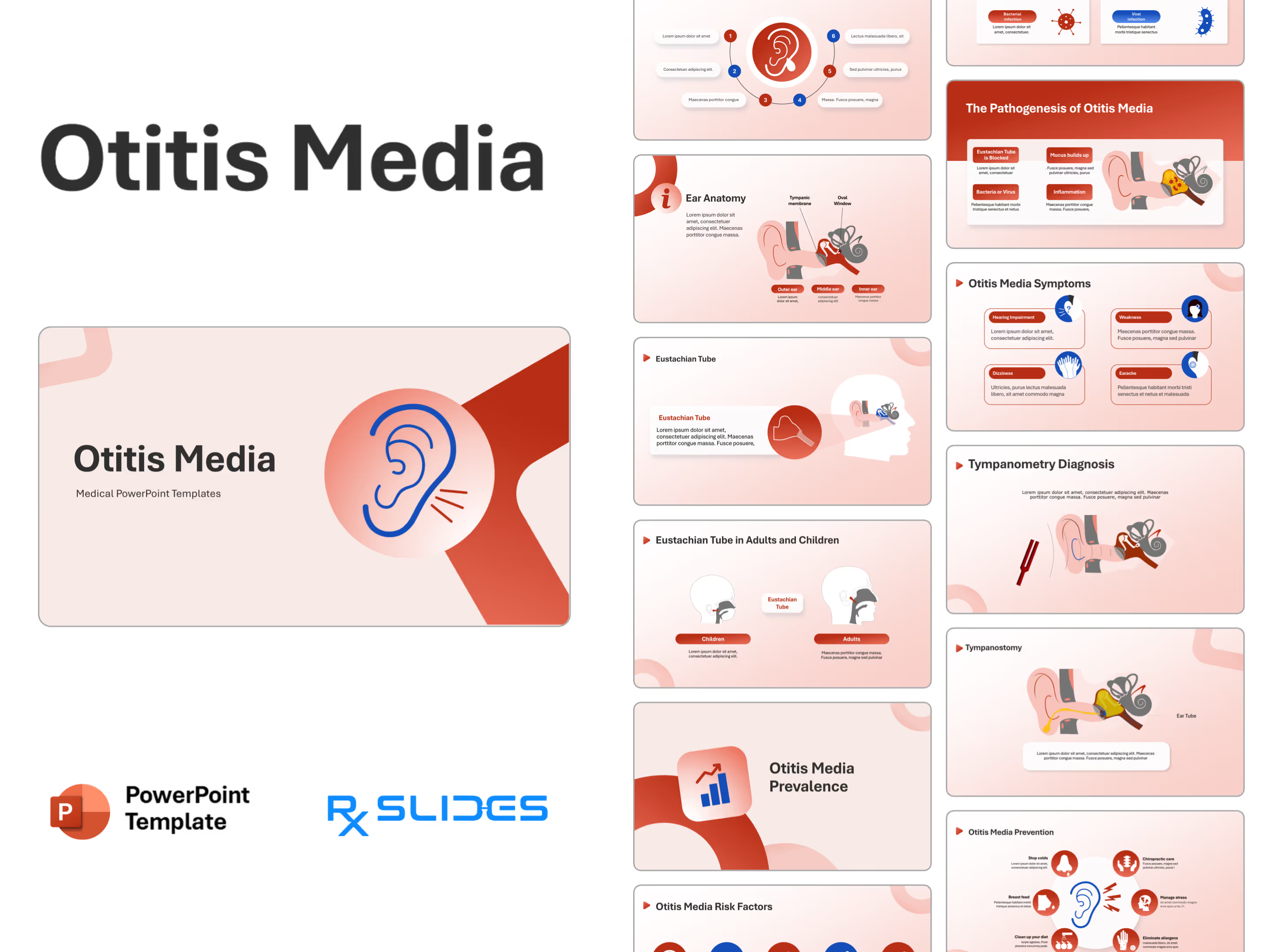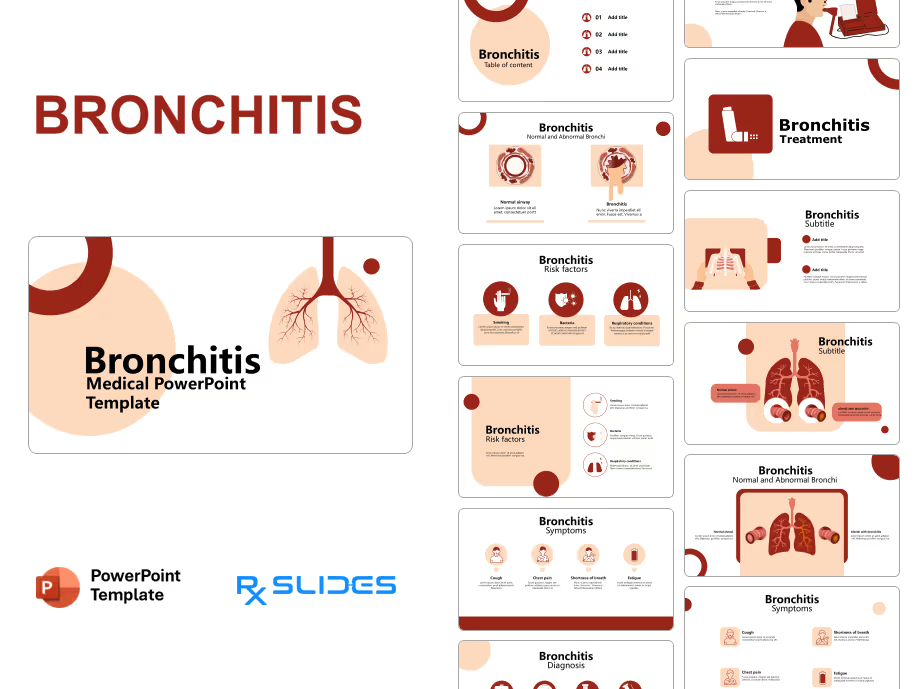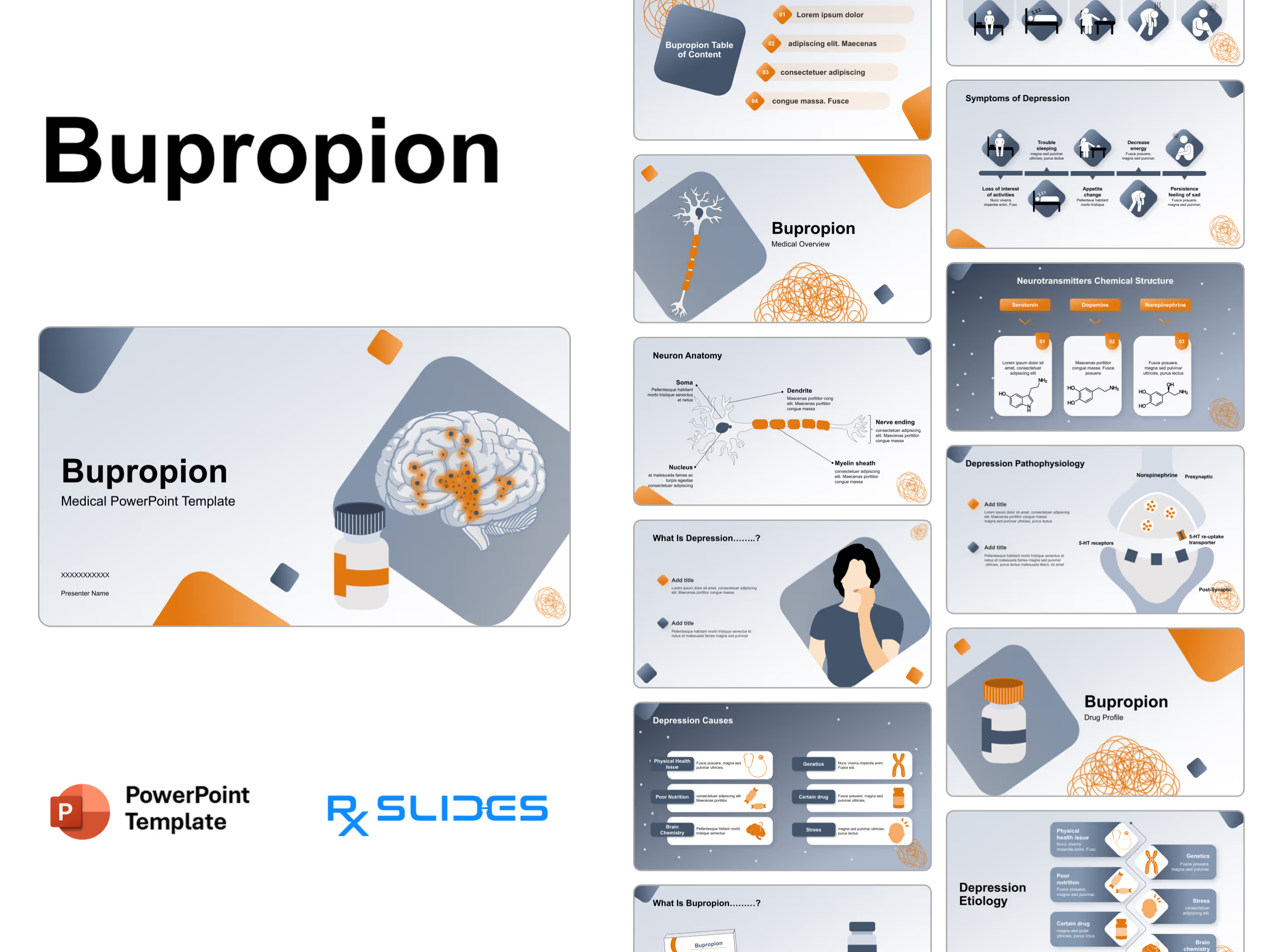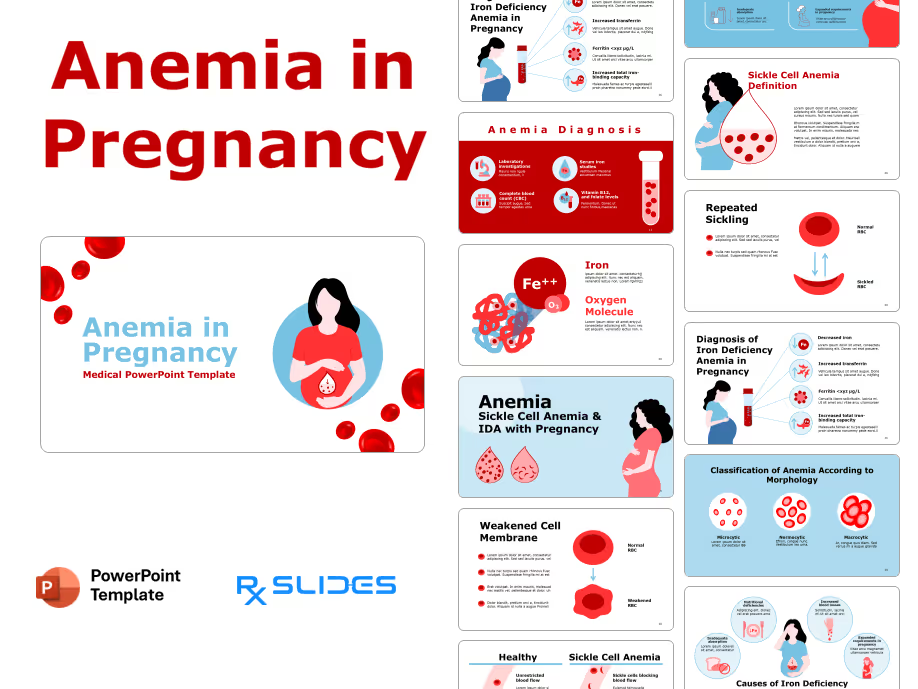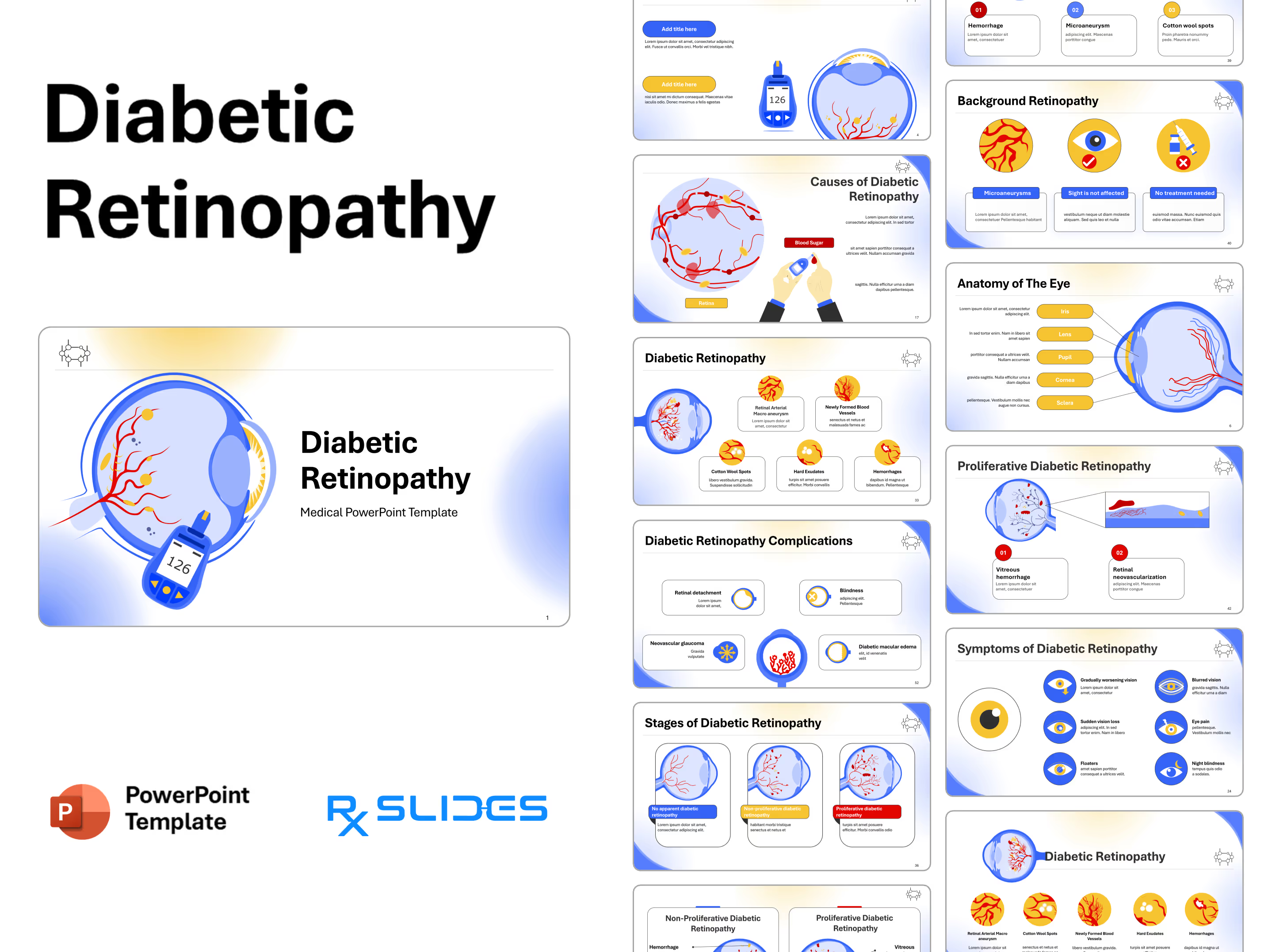Migraine PowerPoint Template
.avif)
Migraine PowerPoint Template: +110 Animated Medical Slides
- The Migraine PPT template is a dynamic medical PowerPoint template that will help you realize the maximum potential of your presentation.
- RxSlides carefully crafted slides, which include medical animations and infographics, will attract your audience.
- You can rely on our customized infographics to give your audience a dynamic and attractive Migraine presentation.
- Explore a wide collection of CNS PowerPoint Templates tailored for various neurological topics. From fundamental anatomy and physiology to various neurological disorders, we offer a comprehensive range to suit your specific needs.
Migraine PowerPoint Template Content
- Your Migraine PPT template begins with attractive cover slides.
- A customizable table of contents that will help you describe the presentation's content.
Migraine Symptoms: Animated Medical icons and characters
- Migraine is a genetically influenced complex disorder characterized by episodes of moderate-to-severe headaches, typically unilateral and often accompanied by vertigo and sensitivity to light and sound.
- Vertigo, vomiting and extreme sensitivity to light and sound are common migraine symptoms, typically on one side of the head.
- visualizations of throbbing pain or a pulsing sensation are used to illustrate migraine signs and symptoms in the Migraine PowerPoint template.
- A comparison slide between Migraine and headache shows Migraine vs. headache and provides space for your comparison points.
.avif)
Animated slides explaining types
- Principally, there are three varieties of migraines: Migraine with aura, Migraine without aura and chronic Migraine.
- These types are illustrated in our Migraine PPT template.
- A chronic migraine is a headache that occurs on 15 or more days per month for more than three months and has migraine symptoms on at least eight or more days per month.
- Status migraineurs have an incapacitating migraine attack that lasts 72 hours.
- A persistent aura without infarction is an aura that persists for more than a week without evidence of infarction on neuroimaging.
- Migraine infarction refers to one or more aura symptoms associated with cerebral ischemia or neuroimaging during a typical migraine attack.
- A seizure is induced during an aura-accompanied migraine attack. (slide No. 2
.avif)
- Medical illustrations supply more information about migraine auras.
- Migraine with aura type is characterized by recurrent, completely reversible attacks lasting minutes and typically involving one or more of the unilateral symptoms listed below: visual, sensory, speech and language, motor, brainstem and retinal. Headaches and migraine symptoms are often present as well.
Etiology of Migraine: Animated Slides
- According to the National Institute of Health (NIH) publication, the etiology is primarily genetic.
- Showing the genes responsible for Migraine is extremely difficult.
- The risk of migraines in relatives of unwell patients is three times that of relatives of healthy individuals.
Medical icons illustrating Migraine triggers
- According to the American Migraine Foundation, some triggers are illustrated in the Migraine PPT template, such as:
Menstruation, ovulation, pregnancy. - The weather varies. Excessive or inadequate sleeping duration, Perfumes, colognes and petroleum distillates produce odors.
- Exposure to light (likely factor), alcohol (wine is a possible factor), smoking (unproven element) and insufficient sleep.
- Temperature, food (chocolate), physical activity, and sexual activity.
- You can add and remove icons from the icons found after the Migraine PPT presentation, filled with customizable icons for the mentioned triggers.
.avif)
Medical infographics showing migraine epidemiology
- The medical infographic shows that Migraine affects 12% of the population and affects up to 17% of women and 6% of men.
- It is the second-leading cause of disability in the world. Migraine is often inherited.
- Infographics show that if one parent has a history of Migraines, the risk is 40%; if both parents have an account of Migraine, the risk increases to 75%.
Infographics explain that attacks tend to increase during the first trimester but are predicted to decrease later in pregnancy, even though attacks are typically less prevalent during the second and third trimester. - Migraine is the most common primary headache disorder in children and adolescents.
- The illustration shows that up to 18% of pediatric emergency room patients are diagnosed with migraines.
- You can alter the mentioned data with your updated numbers, as all infographics are well-editable and customized. (slide No. 4)
.avif)
Diagram illustrating clinical phases of migraine attack
- The relationship between time and severity is illustrated in an animated diagram demonstrating four phases of Migraine prodrome, aura, headache and postdrome.
medical illustrations explaining prodrome
- Medical icons visualize symptoms associated with the activation of the hypothalamus (dopamine).
- Medical illustrations show frequent symptoms, including yawning (34%), mood change, lethargy, neck symptoms, light sensitivity, restlessness, vision focusing difficulties, chill, craving, sound sensitivity, sweating, excess energy, thirst and edema.
- As illustrated in the Migraine PPT template, Hypothalamic neurons activate nociceptive and trigeminal pathways via increased parasympathetic tone, according to one theory of the prodrome phase of migraines.
- The threshold for brain stem neurons to transfer nociceptive and trigeminal signals is decreased in the prodrome phase of Migraine.
Medical illustrations explaining aura
- Medical infographics show that approximately 25% of cases of aura exhibit alterations in cortical function, blood circulation and neurovascular integration. It may presage a headache or co-occur.
- Both positive and negative symptoms are illustrated.
- As medical icons show, bright lines or shapes, tinnitus, sounds, paresthesia, allodynia, or rhythmic movements are positive symptoms caused by neuronal activity in the central nervous system.
- Medical illustrations show negative symptoms such as a lack of or loss of function (reduced or lost vision, hearing, sensation, or movement).
They must be completely reversible. It typically manifests as tingling on one side of the face or a limb, c paresthesia. - The most prevalent positive visual symptom is the scintillating scotoma, a blind spot with a shimmering or shining zigzag border, as discussed in the Migraine PPT template with medical illustrations.
- Visual field defects are the most frequent negative visual symptom; the most common auras are those that are visible.
Sensory auras are also prevalent; they can go with visual symptoms or occur independently.
.avif)
Animated illustrations explaining the suggested mechanism of the headache phase
- The activation of the trigeminal vascular pathway, which begins when nociceptive neurons emit vasodilating neuropeptides, is hypothesized to cause the headache phase of migraines.
- In addition, an axon-like reflex that converges input from nearby skin and muscle to activate the trigeminal cervical complex stimulates trigeminal neurons.
All these phases are explained with RxSlides icons and illustrations in our Migraine PPT template.
Animated mechanisms illustrating treatment options
- A medical illustration shows how different drugs prevent cranial vasodilation caused by GERP. It is expected to increase the severity of headaches or Migraine, so other mechanisms are illustrated as follows:
- CGRP receptor blockers prevent cranial vasodilation by blocking CGRP receptors.
- 5HT1D receptor agonists prevent CGRP release.
- 5HT1B receptor agonists cause vasoconstriction of cranial blood vessels
- Animated slide show comparative illustration for different mechanisms for a deeper understanding of Migraine PPT.
- 5HT1F agonists are preferred over 5HT1B agonists because they cause vasoconstriction without cardiovascular side effects.
- You can add or remove the treatment options on these PowerPoint slides.
- Medical illustrations explain different prophylactic methods.
- Beta-blockers, CGRP antagonists, or calcium channel blockers are used for prophylaxis.
.avif)
RxSlides set medical illustrations explaining mechanisms
- RxSlides set of Medical Illustrations with animations are offered in the end of the migraine PPT Template.
.avif)
RxSlides Set of medical Icons
- different medical icons are illustrated and customized to be used in the Migraine PPT template.
.avif)
Features of the Template
- 100% editable PowerPoint template.
- Editable colors, you can change according to your presentation style and company branding guidelines.

.avif)
.avif)
.avif)
.avif)
.avif)
.avif)
.avif)
.avif)
.avif)
.avif)




.avif)
